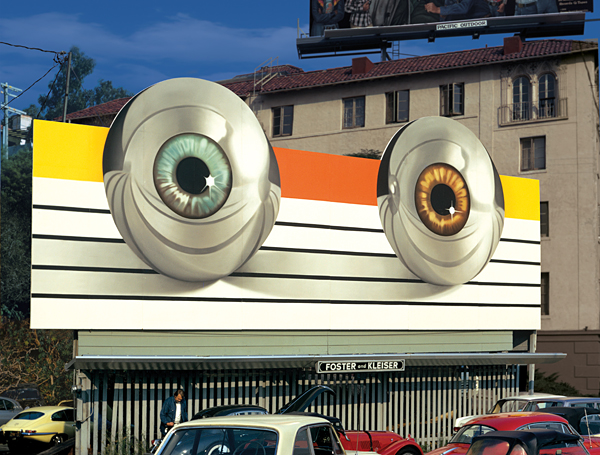
EDITOR’S NOTE: Because of projected rain, the outdoor exhibition of Robert Laudau’s “Rock ‘n’ Roll Billboards of The Sunset Strip” at 8775 Sunset Blvd. has been moved from Feb. 7 to Feb. 14. This story has been updated to include the change.
Pointedly relevant in an era of renewed social protest, “There’s Something Happening Here…On The Sunset Strip 1966” is a series of events and exhibits marking the 50th anniversary of the Sunset Strip riots,and spotlighting the significance of the music, activism and revolution that united and shaped a generation.
Presented by the City of West Hollywood through WeHo Arts, the programming continues in the new year on Feb. 8 with “The Rise of Counterculture in West Hollywood: Art, Music and Poetry,” an event featuring author and culture historian Domenic Priore. Priore is author of “Riot on the Sunset Strip: Rock ‘n’ Roll’s Last Stand in Hollywood,” (Jawbone Press, London, 2015). Priore’s talk will take place in the City Council Chambers, 625 N. San Vicente Blvd., south of Santa Monica. Free parking validation will be available for the five-story parking structure adjacent to the library. Attendees can RSVP online.
In his talk, Priore will explore the moment between 1965 and 1966 that the Sunset Strip in West Hollywood became the epicenter of the folk music scene, which previously had been in Greenwich Village in New York City. That turning point began when Bob Dylan first took the stage with The Byrds at Ciro’s. The scene grew and flourished as musicians and bands such as Frank Zappa, Love, The Doors and Buffalo Springfield became world-famous – as did venues including Whisky a Go Go, It’s Boss, The Trip, The Galaxy and Pandora’s Box. The 1966 closure of the latter club incited the so-called “Sunset Strip Riots,” which later inspired Buffalo Springfield’s hit “For What It’s Worth,” an indelible anthem of the protest era. WeHo Arts’ program title “There’s Something Happening Here…On The Sunset Strip 1966” plays off the song’s most famous lyric.

In addition to the November 1966 riots, Priore will discuss other events including the Feb. 11, 1967, demonstrations on the Strip and across Los Angeles denouncing police raids on a number of Silver Lake area gay bars – a protest that predated NYC’s Stonewall riots by more than two years.
That same month, on Feb. 22, a benefit concert headlined by Peter, Paul and Mary was held to pay for damages to business that suffered during the Sunset Strip riots. Fresh off the success of that show, organizer Alan Pariser – along with Ben Shapiro, Lou Adler, Derek Taylor, John Phillips and Jim Dickson – set up shop on Sunset Boulevard. They organized a massively bigger event that would be a pivotal moment in the 1967 Summer of Love, the Monterey Pop Festival.
In March 1967, as continued protests on the Strip began to identify with the far more violent police brutality in South Central L.A., civil rights hero Julian Bond addressed a crowd at the Fifth Estate, the Sunset Boulevard coffeehouse that the Los Angeles Free Press operated out of from 1964-1966, as did RAMCOM (Right of Assembly and Movement Committee), which called for the original protest.
Also part of “There’s Something Happening Here…On The Sunset Strip 1966,” the outdoor exhibition “Rock ‘n’ Roll Billboards of The Sunset Strip” by photographer Robert Landau will be installed at 8775 Sunset Blvd. on Feb. 14. Landau’s photographs, blown up to a height of 8 feet and a width of 13, capture the era when bigger-than-life record company billboards promoting music icons including The Beatles, David Bowie, Led Zeppelin, Marvin Gaye, and Diana Ross, among many others transformed the Sunset Strip into the world’s largest drive-through art gallery.
Back in the day, Landau was a kid with his first camera, living a block off the Strip. He noticed that the billboards, hand-finished by highly trained commercial painters, had a short life span, and would routinely be changed to advertise new albums and artists. He began shooting the billboards so he could have slide shows for friends who wouldn’t otherwise get to see them.
Spanning 1967 – 1980, Landau’s Kodachromes ended up being the only extensive collection of photographs that document these pop culture artworks. Landau’s book “Rock ‘n’ Roll Billboards of the Sunset Strip” was published by Angel City Press.
“There’s Something Happening Here…,” an exhibition of work by legendary rock ‘n roll photographer Henry Diltz, is on view through May 3 on the second floor of the West Hollywood Library (open during regular library hours). Diltz’s images celebrate the performers integral to the Sunset Strip scene and its legendary music clubs, as well as the community of artists that existed in the hills just above West Hollywood in Laurel Canyon. For more than 40 years, Diltz’s work has graced hundreds of album covers and been featured in books, magazines and newspapers. His unique artistic style has produced powerful photographic essays on Woodstock, the Monterey Pop Festival, The Doors, Crosby, Stills, Nash & Young, Jimi Hendrix, and scores of other artists.


